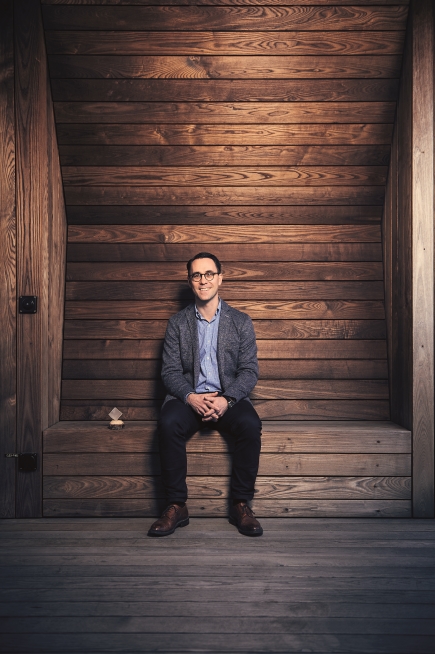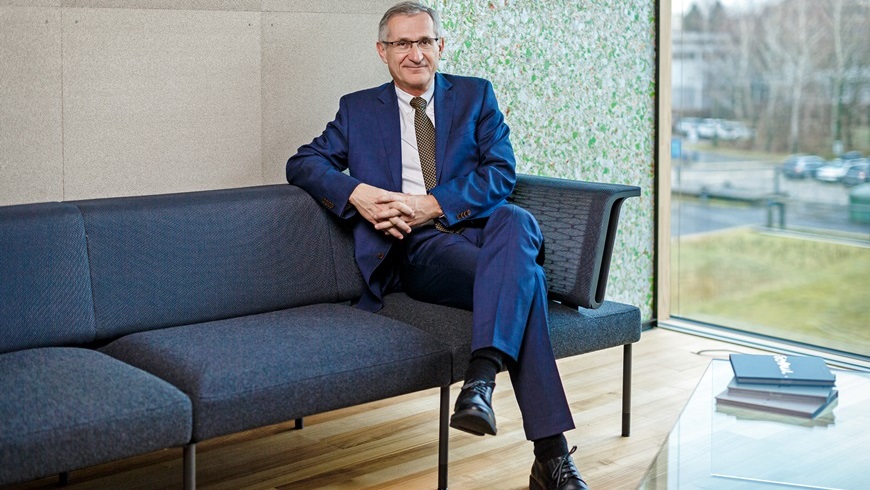Portrait Gustav Nyström
The wood magician
The new head of Empa's Cellulose & Wood Materials lab, Gustav Nyström, has taken everyone by surprise by setting unconventional goals. However, paper batteries and nanocellulose sensors have one main objective: to help solve fundamental, socially relevant questions.

Rebuilding wood
In times of climate change, the researcher is convinced that we should rely on CO2-neutral raw materials. And thus he is in line with the current creative minds who design skyscrapers and even bikes made of wood. Nyström also wants to maximize the potential wood harbors as a raw material by equipping it with completely new properties. If wood becomes electrically conductive or magnetic, or if its structure is modified with the aid of microorganisms, for instance, innovative composite materials can be developed for novel applications.
Nyström is focusing on the pressing problems of our time, such as energy storage, and endeavors to find solutions based on new materials. These include batteries made of sustainable raw materials, which degrade on their own in the environment, but also drinks bottles made of wooden components – buzzword plastic waste. With this in mind, his team is developing wood-based polymers and cellulose particles in combination with proteins, which should one day replace problematic everyday objects such as plastic bottles or transparent packaging film, without polluting the oceans in the form of garbage islands. For Nyström, lemonade in cellulose bottles and foils made of environmentally friendly polymers is not just wishful thinking, but an absolute necessity
“As a researcher, I want to understand the relationships between these kinds of new high-performance materials. But above all I want my work to contribute to a better future,” says Nyström. One of his new projects at Empa is a battery ... made of paper. “Certain structures in wood can be used to store energy,” he explains. The Swede’s PhD thesis in Uppsala had already focused on energy-saving nanofibrils made of natural cellulose.
Drinking bottles made from wood

Nyström is focusing on the pressing problems of our time, such as energy storage, and endeavors to find solutions based on new materials. These include batteries made of sustainable raw materials, which degrade on their own in the environment, but also drinks bottles made of wooden components – buzzword plastic waste. With this in mind, his team is developing wood-based polymers and cellulose particles in combination with proteins, which should one day replace problematic everyday objects such as plastic bottles or transparent packaging film, without polluting the oceans in the form of garbage islands. For Nyström, lemonade in cellulose bottles and foils made of environmentally friendly polymers is not just wishful thinking, but an absolute necessity.
He is convinced that the diversity of his team is an essential ingredient in his recipe for success. For instance, he sets great store by having experts from as many different disciplines as possible in his team. It might sound unusual that, as a physicist, he is proving successful in his present research field. Surrounded by chemists, wood scientists and biophysicists, however, the thinking is always flexible and, above all, critical. And only in this melting pot of disciplines can creativity thrive.
The same goes for the researchers’ backgrounds. “I appreciate the international nature of our team,” says Nyström. “The researchers bring interesting experiences to the table, and we benefit from the fact that different topics are taught in a different style at foreign universities.” Nyström himself studied in Sweden and Germany. But this wasn’t his childhood dream: “I grew up in the country. When I was a boy, I wanted to become a fisherman. I had no concept of what a ‘professor’ was.” Today, he describes himself as creative, focused and, above all, well organized. “I have three young children. I have to find practical and consistent solutions to strike a good balance between the time I spend on my career and with my family and to be able to cope with my hectic everyday life.”
Moreover, he believes the success of a team is also based on the openness, with which it communicates. “Creativity can only thrive if thoughts and information are shared and challenged.” If everyone is reluctant to risk sharing his or her ideas, no new projects will ever come about.
At eye level with Canada
Andrea Six
Communications
Phone +41 58 765 61 33
redaktion@empa.ch

Interview with Gian-Luca Bona
“If we don't seize this opportunity, others surely will”
Empa CEO Gian-Luca Bona on the opportunities and risks of digitalization – and the question as to how a materials research institute needs to gear itself up for this future. More.

Predict the properties of composite materials
How to program materials
Can the properties of composite materials be predicted? Empa scientists have mastered this feat and thus can help achieve research objectives faster. This leads, for instance, to better recycling techniques and electrically conductive synthetic materials for the solar industry.

Sustainable heating and cooling technology
Cooling with the sun
Can you cool with waste heat? Sure. A Swiss research project involving Empa, which ended in November, demonstrated this in an impressive way. Now a large-scale EU project is starting: industrial cooling – thanks to the Spanish sun. More.
